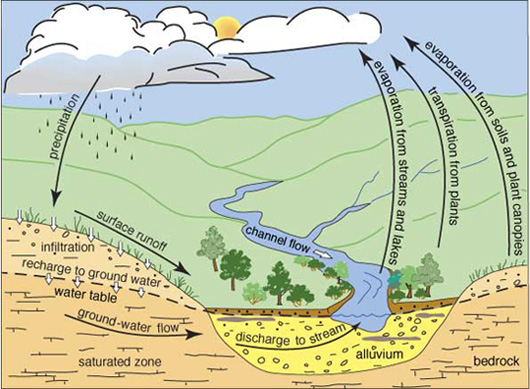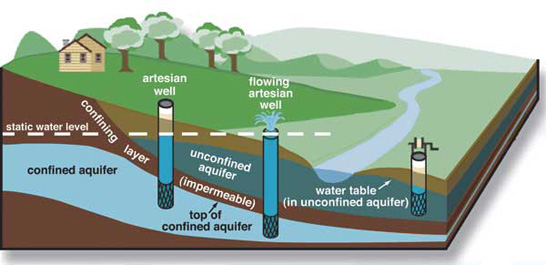Introduction
Whether you are thinking about drilling a water well on your property or about buying land and would like to know the potential for drilling on that property, you should consider many things.
There are no simple solutions, no detailed maps of ground-water presence, and no guarantees. But information is available that can be helpful when making a decision about whether to drill, or where to drill. This publication discusses points to consider when evaluating water-well potential and outlines basic steps to get the information you need. To further your understanding of the available information and why some areas provide water and others do not, we begin with a brief discussion of basic principles that govern ground-water occurrences.
Understanding Ground-Water Systems
Ground Water on the Move: Ground water is defined as underground water found in the pore space of rocks. Ground water does not stay underground forever, and it does not lie still waiting for us to draw it from a well. Ground water moves as part of the hydrologic cycle, the endless circulation of water from the atmosphere onto the surface and into the subsurface regions of the earth and then back from the surface to the atmosphere (fig. 1). Precipitation becomes surface water, soil moisture, and ground water. Like surface water, ground water flows toward and into streams, rivers, marshes, and lakes. Ground water circulates back to the surface in this way, and, from the surface, water returns to the atmosphere through evaporation and transpiration (plant respiration).
The process by which water from rainfall and melting snow seeps into the soil and percolates into the saturated zone is called recharge. Places where recharge occurs are referred to as recharge areas. When this water reappears at the ground surface, this is called discharge. Besides flowing into streams, marshes, and lakes, ground water also may discharge in the form of springs and flowing wells.
Ground Water and Aquifers: Many terms are used to describe the nature and extent of ground-water resources. The level below which all the pore spaces in the ground are filled with water is called the water table (fig. 1). The entire region below the water table is called the saturated zone, and water in this saturated zone is called ground water.
Figure 1–The hydrologic cycle. Precipitation falls to the earth’s surface, runs off or infiltrates the ground, then moves back to the surface and into the atmosphere through transpiration or evaporation. The alluvial aquifer is the cross sectional area shown in yellow and labeled alluvium.

An aquifer is an underground formation of permeable rock or loose material that can produce useful quantities of water when tapped by a well or as discharge via a spring.
Porous media aquifers consist of aggregates of individual particles such as sand or gravel. Ground water fills and moves through the openings between the grains. Porous media where the grains are not connected to each other are unconsolidated. For example, an alluvial aquifer consists of loose sand, gravel, silt, and clay deposited in a stream valley or floodplain, and it is hydrologically connected to the stream flowing on its surface (figs. 1 and 2). In consolidated aquifers, such as sandstone aquifers, grains in the porous media are cemented together.
Figure 2–Confined and unconfined aquifers and how they affect water levels in wells screened in each type of aquifer.
There are no simple solutions, no detailed maps of ground-water presence, and no guarantees. But information is available that can be helpful when making a decision about whether to drill, or where to drill. This publication discusses points to consider when evaluating water-well potential and outlines basic steps to get the information you need. To further your understanding of the available information and why some areas provide water and others do not, we begin with a brief discussion of basic principles that govern ground-water occurrences.

Fractured aquifers are rocks in which ground water moves through cracks, joints, or fractures in otherwise solid rock. Some limestones are fractured aquifers.
Unconfined aquifers are bound by the water table; that is, they have no confining rock layers over the top of them (fig. 2). A well sunk into an unconfined aquifer will encounter water when the well reaches the water table, which is the approximate level at which water will stand in the well. Some aquifers, however, lie beneath layers of impermeable materials. These are called confined aquifers, or sometimes artesian aquifers. A well in such an aquifer is called an artesian well. The water in these wells rises above the top of the aquifer because of confining pressure; the level to which it rises is called the static water level. If the water level rises above the ground surface, a flowing artesian well occurs.
Drilling a well into an unconfined aquifer is often easier and less expensive than drilling into a confined aquifer. Unconfined aquifers are generally nearer the surface, so wells are shallower. Also, many unconfined aquifers are unconsolidated (for example, alluvial aquifers), thus more easily drilled, whereas confined aquifers more often are reached by drilling through hard rock. On the other hand, near-surface, unconfined aquifers are more susceptible to contamination than confined aquifers that are sealed off from surface contaminants.
Ground-water Quality and Contamination: Water is never found in a pure state in nature. Both ground water and surface water may contain many constituents, including minerals, microorganisms, gases, and inorganic and organic materials. Some are present naturally, and others are human-induced.
The chemical nature of water continually changes as it moves through the hydrologic cycle. Although ground-water chemistry depends, in part, on the initial chemistry of the precipitation and recharge water, the most important natural changes in ground-water chemistry occur in the soil. Ground water may dissolve substances it encounters or it may deposit some of its constituents along the way. The eventual quality of the ground water depends on the kinds of rock and soil formations through which it flows. Thus, ground water in some areas may be too salty or contain too much bicarbonate of soda for domestic use or irrigation. Iron content can be very high in some settings, which usually does not render the water unusable, but it can be a nuisance because of rust staining of plumbing fixtures and an undesirable taste and smell. It is advisable to have the water in a new well tested to determine its quality and suitability for use.
Drilling a Well Versus Connecting to a Public Water Supply
